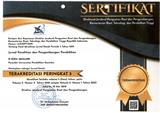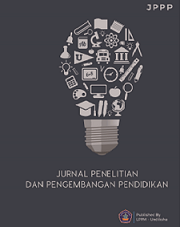Digital Library in Education Administration Management
DOI:
https://doi.org/10.23887/jppp.v6i3.53019Keywords:
Digital Library, Education, Administration ManagementAbstract
Digital libraries are a solution to the weaknesses of conventional libraries, because the characteristics of their collections are in digital form so as to provide convenience for users in terms of access that can be done anywhere and anytime. Digital libraries are currently experiencing a fairly good development. Its application is also found in various libraries, one of which is school libraries, both in junior and senior high schools. This study aims to analyze the effectiveness of digital libraries in the management of education administration in high school in terms of context, input, process, and product aspects. This research is an evaluation research with a quantitative approach. The population in this study is education staff. The sampling technique is done randomly. Data were collected using questionnaires, documentation and interviews. The steps for data analysis are as follows; 1) Change the raw score into a Z score (z-score), 2) Change the score of each CIPP variable into a T-Score, 3) Determine the direction of the T-Score for the Cotext, Input, Process and Product variables, 4) determine the direction of the T-Score score to the Glickman quadrant. The results obtained from the overall evaluation of the context, input, process, and product variables on the use of digital libraries, it was found that the effectiveness of using digital libraries was quite effective. The obstacles faced by digital libraries in managing education administration in high schools are the absence of a clear legal basis, vision, mission, goals, and also that digital library managers do not have academic qualifications according to their fields.
References
Agung, A. A. G., & Koyan, I. W. (2016). Evaluasi Program Pendidikan (Fungsi Manajemen Kontrol). Universitas Pendidikan Ganesha.
Aharony, N. (2014). The effect of personal and situational factors on LIS students’ and professionals’ intentions to use e-books. Library & Information Science Research, 36(2), 106–113. https://doi.org/10.1016/j.lisr.2014.01.001. DOI: https://doi.org/10.1016/j.lisr.2014.01.001
Alchamdani, A., Fatmasari, F., Rahmadani Anugrah, E., Putri Sari, N., Putri, F., & Astina, A. (2020). The Impact of Covid19 Pandemic on Online Learning Process in the College at Southeast Sulawesi. Jurnal Kesehatan Lingkungan, 12(1si), 129. https://doi.org/10.20473/jkl.v12i1si.2020.129-136. DOI: https://doi.org/10.20473/jkl.v12i1si.2020.129-136
Ashiq, M., Jabeen, F., & Mahmood, K. (2022). Transformation of libraries during Covid-19 pandemic: A systematic review. Journal of Academic Librarianship, 48(4), 102534. https://doi.org/10.1016/j.acalib.2022.102534. DOI: https://doi.org/10.1016/j.acalib.2022.102534
Avando Bastari, Adi Bandono, & Okol Sri Suharyo. (2021). The development strategy of smart campus for improving excellent navy human resources. Global Journal of Engineering and Technology Advances, 6(2), 033–043. https://doi.org/10.30574/gjeta.2021.6.2.0011. DOI: https://doi.org/10.30574/gjeta.2021.6.2.0011
Beer, P., & Mulder, R. H. (2020). The Effects of Technological Developments on Work and Their Implications for Continuous Vocational Education and Training: A Systematic Review. In Frontiers in psychology (Vol. 11, p. 918). https://doi.org/10.3389/fpsyg.2020.00918. DOI: https://doi.org/10.3389/fpsyg.2020.00918
Butson, R., John, S., & Suazo, A. (2020). The Behaviour of Learning: Exploring Independent Study Practices of Undergraduate Heath Science Students. Medical Science Educator, 30(2), 917–925. https://doi.org/10.1007/s40670-020-00974-5. DOI: https://doi.org/10.1007/s40670-020-00974-5
Chisita, C. T., Chiparausha, B., Tsabetse, V., Olugbara, C. T., & Letseka, M. (2022). Remaking academic library services in Zimbabwe in the wake of COVID-19 pandemic. Journal of Academic Librarianship, 48(3), 102521. https://doi.org/10.1016/j.acalib.2022.102521. DOI: https://doi.org/10.1016/j.acalib.2022.102521
Cox, A. M. (2019). Learning bodies: Sensory experience in the information commons. Library & Information Science Research, 41(1), 58–66. https://doi.org/10.1016/j.lisr.2019.02.002. DOI: https://doi.org/10.1016/j.lisr.2019.02.002
Díez, F., Villa, A., López, A. L., & Iraurgi, I. (2020). Impact of quality management systems in the performance of educational centers: educational policies and management processes. Heliyon, 6(4), e03824. https://doi.org/10.1016/j.heliyon.2020.e03824. DOI: https://doi.org/10.1016/j.heliyon.2020.e03824
Eighmy-Brown, M., McCready, K., & Riha, E. (2017). Textbook access and affordability through academic library services: A department develops strategies to meet the needs of students. Journal of Access Services, 14(3), 93–113. https://doi.org/10.1080/15367967.2017.1289817. DOI: https://doi.org/10.1080/15367967.2017.1289817
Einarsson, Á. M., & Hertzum, M. (2020). How is learning scaffolded in library makerspaces? International Journal of Child-Computer Interaction, 26, 100199. https://doi.org/10.1016/j.ijcci.2020.100199. DOI: https://doi.org/10.1016/j.ijcci.2020.100199
Fahmi, I. (2002). The Indonesian digital library network is born to struggle with the digital divide. The International Information & Library Review, 34(2), 153–174. https://doi.org/10.1006/iilr.2002.0191. DOI: https://doi.org/10.1080/10572317.2002.10762571
Fox, E. A., & Marchionini, G. (1998). Toward a worldwide digital library. Communications of the ACM, 41(4), 29–32. https://doi.org/10.1145/273035.273043. DOI: https://doi.org/10.1145/273035.273043
Jena, P. K. (2020). Impact Of Pandemic COVID-19 on Education In India. 12(7), 12582–12586. http://journalcra.com/article/impact-pandemic-covid-19-education-india. DOI: https://doi.org/10.31235/osf.io/2kasu
Jeng, J. (2005). What is usability in the context of the digital library and how can it be measured? Information Technology and Libraries, 24(2), 3. https://scholarworks.sjsu.edu/cgi/viewcontent.cgi?article=1043&context=slis_pub. DOI: https://doi.org/10.6017/ital.v24i2.3365
Lawrence, J. E., & Tar, U. A. (2018). Factors that influence teachers’ adoption and integration of ICT in teaching/learning process. Educational Media International, 55(1), 79–105. https://doi.org/10.1080/09523987.2018.1439712. DOI: https://doi.org/10.1080/09523987.2018.1439712
Littlejohn, A., Beetham, H., & McGill, L. (2012). Learning at the digital frontier: a review of digital literacies in theory and practice. Journal of Computer Assisted Learning, 28(6), 547–556. https://doi.org/10.1111/j.1365-2729.2011.00474.x. DOI: https://doi.org/10.1111/j.1365-2729.2011.00474.x
Liu, G. Y., Hu, J. M., & Wang, H. L. (2012). A co-word analysis of digital library field in China. Scientometrics, 91(1), 203–217. https://doi.org/10.1007/s11192-011-0586-4. DOI: https://doi.org/10.1007/s11192-011-0586-4
Lotfy, M. W., Kamel, S., Hassan, D. K., & Ezzeldin, M. (2022). Academic libraries as informal learning spaces in architectural educational environment. Ain Shams Engineering Journal, 13(6), 101781. https://doi.org/10.1016/j.asej.2022.101781. DOI: https://doi.org/10.1016/j.asej.2022.101781
Lyman, P. (2017). What is a digital library? Technology, intellectual property, and the public interest. In Books, Bricks & Bytes, 1–34. https://www.taylorfrancis.com/chapters/edit/10.4324/9781315082073-2/digital-library-technology-intellectual-property-public-interest-peter-lyman. DOI: https://doi.org/10.4324/9781315082073-2
Masrek, M. N., & Gaskin, J. E. (2016). Assessing users satisfaction with web digital library: the case of Universiti Teknologi MARA. The International Journal of Information and Learning Technology. https://www.emerald.com/insight/content/doi/10.1108/IJILT-06-2015-0019/full/html. DOI: https://doi.org/10.1108/IJILT-06-2015-0019
Miniawi, H. El, & Brenjekjy, A. (2015). Educational Technology, Potentials, Expectations and Challenges. Procedia - Social and Behavioral Sciences, 174, 1474–1480. https://doi.org/10.1016/j.sbspro.2015.01.777. DOI: https://doi.org/10.1016/j.sbspro.2015.01.777
Octaviani, A., & Dewi, P. (2019). Evaluasi Kualitas Layanan Perpustakaan Digital Ijateng Menggunakan Metode Digiqual. Jurnal ILmu Perpustakaan, 8(4), 214–227. https://ejournal3.undip.ac.id/index.php/jip/article/download/26873/23713.
Onyema, E. M., Chika, E. N., Ayobamidele, O. F., Sen, S. S., Grace, A. F., Aabha, S., & Omar, A. A. (2020). Impact of Coronavirus Pandemic on Education. Journal of Education and Practice, 11(13), 108–121. https://doi.org/10.7176/jep/11-13-12. DOI: https://doi.org/10.7176/JEP/11-13-12
Park, N., Roman, R., Lee, S., & Chung, J. E. (2009). User acceptance of a digital library system in developing countries: An application of the Technology Acceptance Model. International Journal of Information Management, 29(3), 196–209. https://doi.org/10.1016/j.ijinfomgt.2008.07.001. DOI: https://doi.org/10.1016/j.ijinfomgt.2008.07.001
Pelikan, E. R., Korlat, S., Reiter, J., Holzer, J., Mayerhofer, M., & Schober, B. (2021). Distance learning in higher education during COVID-19: The role of basic psychological needs and intrinsic motivation for persistence and procrastination–a multi-country study. PLoS ONE, 16(10 October), 1–23. https://doi.org/10.1371/journal.pone.0257346. DOI: https://doi.org/10.1371/journal.pone.0257346
Rahim, M., & Hulukati, W. (2021). Development of handbooks of guidance and counseling to enhance elementary school teachers’ competence in cultivating students’ creativity. European Journal of Educational Research, 10(2), 657–670. https://doi.org/10.12973/eu-jer.10.2.657. DOI: https://doi.org/10.12973/eu-jer.10.2.657
Riyanto, S., Marlina, E., & Triasih, H. (2019). Librarian role in research library services in Indonesian Institute of Sciences. Berkala Ilmu Perpustakaan Dan Informasi, 15(2), 201–212. https://doi.org/10.22146/bip.35200. DOI: https://doi.org/10.22146/bip.35200
Rokhim, D. A., Widarti, H. R., & Fajaroh, F. (2020). Pengembangan Bahan Belajar Flipbook pada Materi Redoks dan Elektrokimia Berbasis Pendekatan STEM-PjBL Berbantuan Video Pembelajaran. Kwangsan: Jurnal Teknologi Pendidikan, 8(2), 234–250. http://doi.org/10.31800/jtp.kw.v8n2.p234-250. DOI: https://doi.org/10.31800/jtp.kw.v8n2.p234--250
Sammons, P. (2010). Equity and Educational Effectiveness (P. Peterson, E. Baker, & B. B. T.-I. E. of E. (Third E. McGaw (eds.); pp. 51–57). Elsevier. https://doi.org/10.1016/B978-0-08-044894-7.00419-X. DOI: https://doi.org/10.1016/B978-0-08-044894-7.00419-X
Sari, D. A., Ellizar, E., & Azhar, M. (2019). Development of problem-based learning module on electrolyte and nonelectrolyte solution to improve critical thinking ability. Journal of Physics: Conference Series, 1185(1). https://doi.org/10.1088/1742-6596/1185/1/012146. DOI: https://doi.org/10.1088/1742-6596/1185/1/012146
Selvaraj, A., Radhin, V., KA, N., Benson, N., & Mathew, A. J. (2021). Effect of pandemic based online education on teaching and learning system. International Journal of Educational Development, 85(May), 102444. https://doi.org/10.1016/j.ijedudev.2021.102444. DOI: https://doi.org/10.1016/j.ijedudev.2021.102444
Soyemi, O., Ojo, A., & Abolarin, M. (2018). Digital literacy skills and MOOC participation among lecturers in a private university in Nigeria. Library Philosophy and Practice, 1–18. https://core.ac.uk/download/pdf/188131266.pdf.
Syahdatul, A. (2019). Evaluasi Karakteristik Perpustakaan Digital pada Perpustakaan Digital UNIMED.
Wijayanti, N. I., Yulianti, R., & Wijaya, B. (2019). Evaluasi Program Pendidikan Pemakai Dengan Model CIPP di Perpustakaan Fakultas Teknik UGM. Tik Ilmeu : Jurnal Ilmu Perpustakaan Dan Informasi, 3(1), 37. https://doi.org/10.29240/tik.v3i1.790. DOI: https://doi.org/10.29240/tik.v3i1.790
Woessner, M. N., Tacey, A., Levinger-Limor, A., Parker, A. G., Levinger, P., & Levinger, I. (2021). The Evolution of Technology and Physical Inactivity: The Good, the Bad, and the Way Forward. Frontiers in Public Health, 9, 655491. https://doi.org/10.3389/fpubh.2021.655491. DOI: https://doi.org/10.3389/fpubh.2021.655491
Downloads
Published
How to Cite
Issue
Section
License
Copyright (c) 2022 I Gusti Ketut Arya Sunu

This work is licensed under a Creative Commons Attribution-ShareAlike 4.0 International License.
Authors who publish with the Jurnal Penelitian dan Pengembangan Pendidikan agree to the following terms:
- Authors retain copyright and grant the journal the right of first publication with the work simultaneously licensed under a Creative Commons Attribution License (CC BY-SA 4.0) that allows others to share the work with an acknowledgment of the work's authorship and initial publication in this journal.
- Authors are able to enter into separate, additional contractual arrangements for the non-exclusive distribution of the journal's published version of the work (e.g., post it to an institutional repository or publish it in a book), with an acknowledgment of its initial publication in this journal.
- Authors are permitted and encouraged to post their work online (e.g., in institutional repositories or on their website) prior to and during the submission process, as it can lead to productive exchanges, as well as earlier and greater citation of published work. (See The Effect of Open Access)







